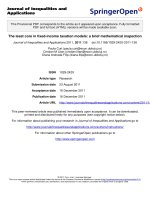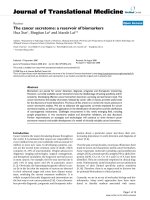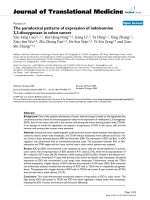báo cáo hóa học:" The 16th International Conference on AIDS: Will It Leave a Legacy?" doc
Bạn đang xem bản rút gọn của tài liệu. Xem và tải ngay bản đầy đủ của tài liệu tại đây (172.72 KB, 2 trang )
BioMed Central
Page 1 of 2
(page number not for citation purposes)
Journal of the International AIDS Society
Open Access
Meeting report
The 16th International Conference on AIDS: Will It Leave a Legacy?
Helene Gayle
1
and Mark A Wainberg*
2
Address:
1
President and Chief Executive Officer of CARE USA, Atlanta, Georgia and
2
Professor and Director of the McGill University AIDS Centre,
Montreal, Canada
Email: Mark A Wainberg* -
* Corresponding author
It was a great honor for us to have served as co-chairs of
the recent 16th International Conference on AIDS
(Toronto, Canada, August 1318, 2006). We were gratified
that attendance eclipsed that of all previously held Inter-
national AIDS conferences. Despite a few glitches, such as
problems with registration at the start of the conference,
most observers concurred that it went extremely well. In
fact, the conference seems to have been judged a great suc-
cess from both the scientific and social standpoints.
Many people have written to thank us for having organ-
ized a conference that was so strong in regard to preven-
tion. This is important, because prevention research is
considered to be crucial in stemming the HIV epidemic.
The conference included important sessions concerning
both microbicides and preventive vaccines. It reported on
key concepts and progress regarding the initiation of clin-
ical trials. The conference included sessions on the impor-
tant concept of pre-exposure prophylaxis. There was
discussion about whether male circumcision might pro-
tect women from being infected by HIV-seropositive part-
ners in addition to protecting men from being infected by
HIV-seropositive women.
In addition, the conference was recognized for the many
compelling articles that dealt with new and improved
treatment strategies for HIV disease. As examples, the con-
ference included some of the most robust data ever pre-
sented on the Merck integrase inhibitor, MK-0518
(subsequently named raltegravir).[1,2] In a trial per-
formed on drug-naive subjects, this compound was
shown, in combination with lamivudine (3TC) and teno-
fovir, to yield the most rapid drops in HIV RNA viral load
ever seen in the history of HIV disease. Other compelling
presentations included the results of the KLEAN trial that
compared lopinavir/r vs ritonavir-boosted fosamprinavir
in a randomized controlled trial in which patients also
received the nucleoside analog reverse transcriptase inhib-
itor (NRTI) combination of 3TC/abacavir.[3] In addition,
novel data were presented on 2 promising CCR5 corecep-
tor antagonists that block HIV entry into cells and are
being developed by Pfizer and Schering.[4,5] A sense of
genuine enthusiasm emerged from the Toronto confer-
ence regarding the fact that our armamentarium of thera-
peutic drugs will soon include members of 2 novel
additional classes integrase inhibitors and CCR5 inhibi-
tors. Optimism was also expressed regarding the consider-
able progress that has been made toward the use of
antiretroviral drugs in prevention strategies.
At the same time, however, it was recognized that we must
make more progress regarding bringing the benefits of
antiviral therapy to HIV-infected individuals in develop-
ing countries. Sadly, AIDS will develop in these individu-
als who will die unless these lifesaving medications can be
made available to them as quickly as possible. Despite
considerable progress during the past 6 years regarding
antiretroviral drug access, the reality is that more people
became newly infected by HIV-1 during 2006 than had
access to antiretroviral drugs. As long as this situation per-
sists, it is difficult to imagine that we will win the global
battle against AIDS. We are grateful that there now seems
to be consensus throughout the world that nothing must
be permitted to interfere with the rights of HIV-infected
individuals to gain access to antiretroviral drugs, regard-
less where they live or their ability to pay. Nothing,
including the potential problem of HIV drug resistance,
must be permitted to interfere with attainment of this
goal. This concept was symbolized by the theme of the
conference, "Time to Deliver," that underlined the fact
Published: 19 April 2007
Journal of the International AIDS Society 2007, 9:15
This article is available from: />Publish with BioMed Central and every
scientist can read your work free of charge
"BioMed Central will be the most significant development for
disseminating the results of biomedical research in our lifetime."
Sir Paul Nurse, Cancer Research UK
Your research papers will be:
available free of charge to the entire biomedical community
peer reviewed and published immediately upon acceptance
cited in PubMed and archived on PubMed Central
yours — you keep the copyright
Submit your manuscript here:
/>BioMedcentral
Journal of the International AIDS Society 2007, 9:15 />Page 2 of 2
(page number not for citation purposes)
that we must all be held accountable regarding the com-
pelling need to bring antiretroviral drugs to everyone in
need.
The International AIDS Conference of 2006 also marked
the first time in recent years that this meeting was held in
a developed country setting, without major demonstra-
tions by activist groups in protest against the actions of
pharmaceutical companies and their booths in the exhibit
areas of the conference. We are grateful for the restraint
that was displayed by many members of activist commu-
nities, who doubtless gave this subject great thought and
consideration. It is likely, however, that there is also
increased appreciation of the distance that many pharma-
ceutical companies have come since 2000 regarding issues
such as compulsory licensing of antiretroviral drugs and
the production of antiretroviral drugs by generic compa-
nies.
The Toronto conference may also be recognized over time
as having played a key role regarding changes in govern-
ment policies toward HIV/AIDS that have now occurred
in South Africa. Many will recall that president Mbeki had
embraced a number of HIV denialists views in the months
before the XIII International Conference on AIDS that was
held in Durban, South Africa, during July 2000. Individu-
als such as Zackie Achmat and Mark Heywood of the
Treatment Action Campaign (TAC) in South Africa and
Justice Edwin Cameron of the South Africa Supreme
Court have long and courageously fought to attain a
reversal of South African government HIV/AIDS policies,
and, together with their colleagues, certainly deserve the
lion's share of credit regarding the rationalization of
South African government policies that has occurred in
recent months. However, their cause was certainly helped
by the fact that numerous speakers at the International
AIDS Conference in Toronto mocked comments by the
South African Minister of Health, Manto Tshabalala-Msi-
mang, who stated at the start of the conference that lemon
juice, beetroot, and garlic were effective means of combat-
ing the HIV epidemic. The comments of these speakers
were picked up by the South African and international
press, with the consequence that the South African gov-
ernment seems to have been embarrassed. In all likeli-
hood, influential members of the African National
Congress, the governing party of South Africa, decided
that they could no longer abide the policies on HIV/AIDS
that have ill-served South Africa during most of the past
decade. We are, of course, delighted that these changes
have now come about and agree that the International
AIDS Conference of 2006 helped to catalyze this shift.
In summary, we believe that the XVIth International Con-
ference on AIDS will indeed have legacy and will be
looked back on as a turning point in the global battle
against the HIV epidemic. Furthermore, it is important to
continue to support the International AIDS Conferences,
as events at which excellent science and social activism
can join forces toward attainment of common objectives
that include effective government policy. We are grateful
to all those who worked with us to ensure the success of
International AIDS Conference in Toronto 2006.
Authors and Disclosures
Mark Wainberg, PhD, has disclosed that he has received
grants for clinical research and educational activities from
GlaxoSmithKline and Boehringer Ingelheim. Dr. Wain-
berg has also disclosed that he has served as an advisor or
consultant to Pfizer and Boehringer Ingelheim.
Helene Gayle, MD, has disclosed no relevant financial
relationships.
References
1. Miller M, Witmer M, Stillmock K, et al.: Biochemical and antiviral
activity of MK-0518, a potent HIV integrase inhibitor. Pro-
gram and abstracts of the XVI International AIDS Conference; August
1318, 2006; Toronto, Ontario, Canada . Abstract THA0302
2. Markowitz M, Nguyen B-Y, Gotuzzo F, et al.: Potent antiretroviral
effect of MK-0518, a novel HIV-1 integrase inhibitor, as part
of combination ART in treatment -naive HIV-1 infected
patients. Program and abstracts of the XVI International AIDS Confer-
ence; August 1318, 2006; Toronto, Ontario, Canada . Abstract
THLB0214
3. Eron J, Yeni P, Gathe J, et al.: The KLEAN study: fosamprenavir
+ ritonavir (FPV/r) versus lopinavir/ritonavir (LPV/r) in
antiretroviral-naive (ART-Naive) HIV-1 infected adults over
48 weeks. Program and abstracts of the XVI International AIDS Confer-
ence; August 1318, 2006; Toronto, Ontario, Canada . Abstract
THLB0205
4. Mayer E, Ryst E van der, Saag M, et al.: Safety and efficacy of Mar-
aviroc (MVC), a novel CCR5 antagonist, when used in com-
bination with optimized background therapy (OBT) for the
treatment of antiretroviral-experienced subjects infected
with dual/mixed-tropic HIV-1: 24-week results of a phase 2b
exploratory trial. Program and abstracts of the XVI International AIDS
Conference; August 1318, 2006; Toronto, Ontario, Canada . Abstract
THLB0215
5. Greaves W, Landovitz R, Fatkenheuer G, et al.: Late virologic
breakthrough in treatment-naive patients on a regimen of
Combivir + vicriviroc. Program and abstracts of the 13th Conference
on Retroviruses and Opportunistic Infections; February 58, 2006; Denver,
Colorado . Abstract 161LB









